by Winding Pathways | Mar 18, 2021 | (Sub)Urban Homesteading, Birds, Garden/Yard, Nature, Trees/Shrubs
March is a pivot month. It’s neither winter nor spring. Often called “mud season”, March is maple syruping time, but it’s also birdhouse building month at Winding Pathways.
As humans in northern climates wade through mud and long for spring, millions of birds far to the south are planning their long migration north. A few hardy waterfowl arrive as soon as the ice melts from lakes and ponds, but most birds appear, as if by magic, in April and May. We make sure our birdhouses are up before they arrive.
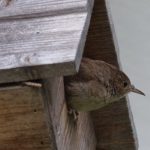
Looking out at the world.
House Wrens, Eastern Phoebes, American Robins, House Sparrows, and House Finches all nest on or near homes, barns, and garages. Although few people enjoy seeing messy House Sparrow nests tucked into nooks and crannies, most love hosting the native species as they raise the new generation outside the window.
Make Birdhouses
March is the best month to make birdhouses and restore older ones somewhat worse for the wear. Most are easy to build using simple carpentry tools. Better yet, birds aren’t fussy. Although the size of the house and the diameter of the entrance hole is important, the residents don’t care if the maker is an excellent carpenter or a novice. So, if the joints don’t fit perfectly it won’t bother birds!
Helping children make birdhouses is a fun project that involves them in nature as they learn safe tool use and basic construction techniques.
We scrounge a nearby pallet pile for free wood. Often the discarded pallets are made from boards the right width for our houses. Relatively inexpensive pine, spruce, or fir work for people who prefer to buy wood.
-
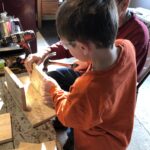
-
Working with children to make a birdhouse is rewarding.
-
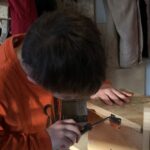
-
Children learn wood types, stages of building and how tools work.
-
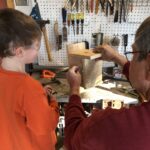
-
The birdhouse is nearly complete.
Great Resources to Guide Your Work
The best information source for virtually anything about wild birds is the Cornell University Laboratory of Ornithology. Their website gives great information on many aspects of birds, including what species likely live in an area. The site is complex but fascinating. A second website, also by the Lab, is more specific to birdhouses and nesting. The Laboratory of Ornithology site helps anyone predict what birds might migrate to their yard and when they’ll arrive. It also includes plans on how to build birdhouses. There’s even a video showing construction tips.
There’s more to birdhouses than just making one. They must be erected in the right place and height above the ground. The Lab’s website provides the right information. And, here are two tips from Winding Pathways.
Tips from Winding Pathways
- Many birdhouse plans to use nails as a hinge so the house can be opened for cleaning. We buy and use small hinges, hooks, and eyes to make opening the box to clean it easier.
- It’s tempting to attach a birdhouse to a tree using a nail or screw. That may work but eventually, the birdhouse falls off. But, the metal remains embedded in the tree. This creates danger as the tree grows around the metal, hiding it. Hitting a nail with a chainsaw is downright scary and dangerous. Also, driving a nail into a live tree can introduce diseases that could kill it. We use wire or rope to attach our birdhouses to live trees and use screws to attach birdhouses to nonliving posts and poles. One of our wren houses is suspended from a hook screwed into our porch ceiling.
Building birdhouses and enjoying a wren couple raises a brood is a fun family activity that we never tire of.
by Winding Pathways | Dec 10, 2020 | (Sub)Urban Homesteading, Garden/Yard, Nature, Trees, Trees/Shrubs
Unusual Storm Clouds
The August storm looked like an ordinary thunderstorm approaching. Dark clouds gathered to the west as we sat on our porch. What happened minutes later was far from normal.
The roaring wind hit like a prize fighter’s fist, bending our small oaks and maples parallel to the ground. Before it struck, we had 53 mature, healthy trees on our two acres. Forty minutes later only six still stood somewhat unravaged. As we watched in dismay and horror our oaks, hackberries, cherries, pines, and Douglas Firs either uprooted or snapped off. At least our beloved black walnut still stood on the edge of the woods.
Then a massive gust later reported to be 140 miles an hour by the National Weather Service, stripped off the walnut’s branches. Soon, the wind calmed, allowing us to see tree carnage and home damage. It was shocking and started three months of clean up and reconstruction. We fixed the house but it’s not possible to replace century-old trees.
A Banner Day
In contrast to the August 10, 2020 derecho, Thursday, November 19 was a banner day.
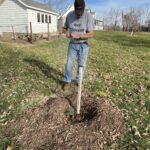
Arbor Day in November
We had just received a box of trees from the National Arbor Day Foundation. After we tucked the oaks, maples, pines, and aspens into the ground we ringed them with a thick layer of wood chips and gave them a good drink of water. The chips came from massive fallen trees the City of Cedar Rapids ground up after the storm. Then we circled each tree with wire mesh to protect it from hungry deer. By afternoon we were tired but elated. We won’t live long enough to see our new trees as giants, but we gave them a good start.
Arbor Day Quality Trees
The baby trees looked great. It was our most recent purchase from the Arbor Day Foundation. Although inexpensive, they looked healthy and eager to grow. Even the bur and white oaks, which have robust and long taproots looked great.
In most places, Arbor Day is celebrated in late April. We’ll plant some more trees then, but we sat on our back deck on a warm November evening and enjoyed seeing our trees in their new homes. For us and our new trees, it was Arbor Day in November.
Lied Lodge and Arbor Day Foundation – Destination
We have visited the Arbor Day Foundation in Nebraska City, Nebraska, several times. It’s where Arbor Day was created. We’ve overnighted at Lied Lodge on the property and enjoyed walking trails on Arbor Day Farm.
So, if you need to buy trees check out arborday.org. Want a pleasant place to visit? The Farm and Lodge are less than an hour’s drive south of Omaha. Although we’ve been there several times, we look forward to returning.
by Winding Pathways | May 30, 2019 | (Sub)Urban Homesteading, Flowers/Grasses, Garden/Yard, Garden/Yard, Nature, Trees/Shrubs
Enjoying a Welcoming Yard
On the evening of May 17th, one of nature’s brightest colors greeted us at Winding Pathways. It was a brilliant male scarlet tanager, a somewhat rare bird that we only see briefly each May.
The next morning, he was joined by a female, and we assume they’ll nest in Faulkes Heritage Woods that adjoins our property. Tanagers are birds of the big woods, and they’ll find comfortable lodging in the big oaks nearby.
We bought Winding Pathways ten years ago partly because it adjoins the 110-acre Woods protected from development by a conservation easement. It’s mostly steep land that drops down to Indian Creek about a quarter of a mile from our home.
Creating a Welcoming Yard
Since we bought our land, we’ve diversified the yard by restoring prairies and increasing the variety of savanna and woodland wildflowers in shady areas, used prescribed fire to reduce exotics, and installed many birdhouses and feeders. Thanks to the nearby woods and our more open prairie yard with the savanna in between, we enjoy a rich array of bird species. Some, like woodpeckers and chickadees, stay around all year but more migrate to nest here or stop by on their trek to nest further north. We keep a running list of the birds we see from our dining room table each spring. Some we just see winging over but many stop to eat and rest.
-
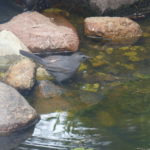
-
Catbird by water
-
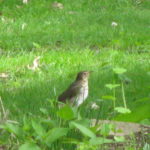
-
The Swainson’s Thrush moves through in the spring.
-
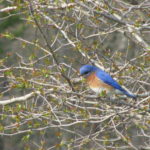
-
Bluebird in tree
Growing Bird List
We’re adding to this list daily but here’s what we’ve spotted and heard so far in May 2019:
Great Blue Heron, Barred and Horned Owl, Canada Goose, Black Capped Chickadee, Tufted Titmouse, Cardinal, White and Red Breasted Nuthatch, Downy, Hairy, Red Bellied, Red Headed, and Pileated Woodpeckers and Flicker, Turkey Vulture, House Sparrow, Wild Turkey, Red Breasted Grosbeak, Northern Oriole, Wood Duck, Common Yellowthroat, Indigo Bunting, Yellow Warbler, Louisiana Waterthrush, Blackpoll Warbler, Yellow Rumped Warbler, Scarlet Tanager, Eastern Kingbird, Phoebe, Great Crested Flycatcher, Cooper’s Hawk, Bald Eagle, Cowbird, House Sparrow, Starling, House and Carolina Wren, House Finch, Red Tail Hawk, Cooper’s Hawk, Crow, Pelican.
-
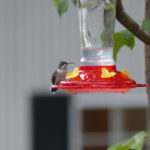
-
A hummer at the feeder.
-
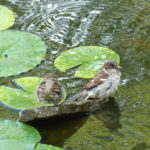
-
A water source helps attract birds.
-
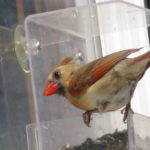
-
Female Cardinal at window feeder.
And the list keeps growing. You, too, can create a welcoming yard. This introductory YouTube video from Canada gives a quick overview of the important elements in attracting birds to a yard. It’s totally “Homegrown” and short. You can create welcoming space on a condominium patio, at a retirement or nursing home, an urban lot or spacious acreage.
Another YouTube video explains how to bring natural elements together to create natural areas. In this case, a “forest.” Again, from large scale to small we can all do this! We would, naturally, adapt to our region of the country and world. The concepts are similar.
What to Consider When Creating a Welcoming Yard
How much time/money do you want to invest?
Do you want to create a naturalistic landscape with native plants?
Do you want to harvest food from the space?
Are your neighbors tolerant of change?
What local codes affect what you want to do? (Ordinances or Covenants)
How prevalent are deer in the neighborhood?
How long do you plan to live in the home?
-
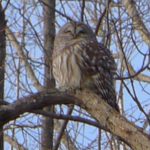
-
Waiting
-
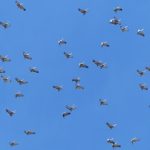
-
Wheeling overhead
-
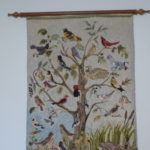
-
A hooked rug by Yvonne Fellows
We’re lucky to have Indian Creek and Faulkes Heritage Woods near Winding Pathways, but even yards not adjacent to natural areas can increase bird variety by creating diverse habitat. Spring is the best season to plant prairies and shrubs! Learn more about birds, their habits and habitats at the Cornell Laboratory of Ornithology.
-
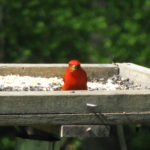
-
Extra nutrition at the feeder.
-
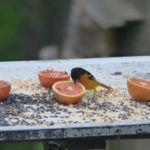
-
A male northern oriole
-
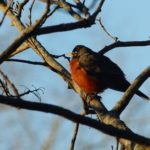
-
A robin surveys the area
by Winding Pathways | Jun 28, 2018 | Nature, Pests, Trees/Shrubs
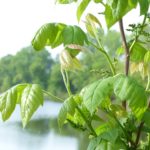
Poison Ivy loves edges
This summer millions of Americans will have unhappy encounters with poison ivy. For most people, the result is a patch of itchy bumpy skin that goes away after a few days to a week or so. Unfortunate others will develop a serious reaction that includes severe itching and swelling.
The very best way to not get a case of poison ivy is to avoid the plant and its culprit – urushiol, an oil that causes the allergic reaction. It’s on the plant’s leaves, in the vines and the sap.
Avoiding urushiol is a surefire way of avoiding a poison ivy rash, but many people have trouble identifying the plant. Fortunately, poison ivy has a secret. Knowing it helps people avoid the plant.
Poison ivy is an amazingly adaptable, hardy and confusing plant. It can be a low growing ankle high sprig, a shoulder high shrub, or a vine winding up to the top of a tall tree. The old saying “Leaves of three, let them be” is only partially helpful in identifying the plant. Usually, it does have leaves in groups of three but many animals love dining on poison ivy and are immune to its ill effects. So, a rabbit or deer may have eaten a leaf, giving the plant leaves of two! And many nonpoisonous plants have leaves of three.
Enter the plant’s secret. Poison ivy is a plant of the edge. It’s rare in the middle of a sun-soaked prairie or in a deeply shaded forest. The plant almost always hugs the edge of a habitat, especially if it gets partial sunshine.
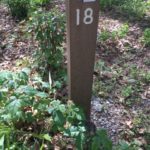
Birds drop seeds when they perch on campground posts.
We’ve seen poison ivy on the edges of:
- Lawns, including ours
- The ocean sand dunes
- Lakes, especially along trails
- Roads
- Trails anywhere
- Ballfields – the rough where balls sometimes go
- Picnic areas
- It especially seems to love life in state park campgrounds especially around the posts that mark a site number and the trees that shade a campground area and that kids love to hug!
So, to avoid poison ivy be especially cautious on the edge. Look carefully at edge plants and study photos of poison ivy in books and on the Internet. Avoid poison ivy when you can.
But, if you accidentally touch the plant or have been wading through likely habitat, get home soon, remove clothes carefully, avoiding touching the outsides of clothes where poison ivy sap may have touched, take a sudsy shower, toss the towels in the laundry, and odds are good that the oil will be soaped off before it creates an allergic reaction.
by Winding Pathways | Jan 25, 2018 | Mammals, Trees/Shrubs
Winter is the best time to spot dens and nests. Usually, we think of bird nests, and we see abandoned ones topped with mounds of snow along roadsides and in shrubs. When we look up, we also spot large clusters of leaves and sticks – squirrel nests.
Squirrels make two types of nests: dens and dreys. Dens are cavities in trees and dreys are the large balls of leaves and sticks that squirrels fashion. From the ground, these dreys look small, but they are really good sized.
Dens
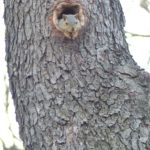
Taking in the view from the safety of a tree den.
When squirrel families mature in late summer, the young venture forth to find new lodgings. If the population of squirrels is low and the availability of hollows in trees is high, then squirrels take the dens. These are hollow spaces inside the trunk that squirrels line with leaves and bits of fur and bark. Squirrels do not create these hollows but use them. Wood rot and woodpeckers create the spaces and squirrels make the most of them. Dens offer great protection from the elements and predators and they are warmer. So, squirrels conserve their energy when they must “hole up” during winter storms. When the worst of the harsh weather passes, squirrels begin to stir, digging for nuts and raiding bird feeders.
Dreys
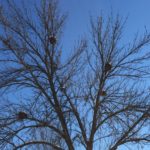
Squirrel Condominium
Squirrels make their dreys near sturdy forks in branches or close to the tree trunk. They will be high up for protection from predators. Usually, a tree might support one or two squirrel nests, but occasionally, we see half a dozen scattered throughout a wide-branching deciduous tree. Squirrel condominiums. These might be secondary homes or extensions of families. Secondary homes tend to be more loosely constructed and are scattered near the main home tree and serve as shelter in case a squirrel gets caught out in the elements or is being chased by a predator.
Each nest begins with a study base of twigs. Scientists have discovered that sometimes squirrels weave grapevines into the structure along with leaves, bark, moss, and twigs for added support. After all, the nest sways in the branches and get buffeted by winds, rain, and snow, so it needs to be strong. Inside, the nest is dry and warm.
When you are driving or walking look up and spot the nests of one of our most industrious small mammals. Squirrels mate in January and soon the young will be born – in the bleak mid-winter maybe in a squirrel condominium near you!
by Winding Pathways | Nov 9, 2017 | Nature, Trees/Shrubs
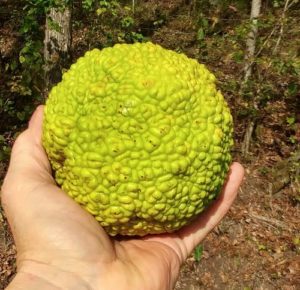 This fall we’ve noticed Osage Orange fruits for sale in grocery stores and roadside stands. They are fascinating and have a delightful fresh citrus scent.
This fall we’ve noticed Osage Orange fruits for sale in grocery stores and roadside stands. They are fascinating and have a delightful fresh citrus scent.
These are often called Hedge Apples, and many people call the tree they grow on Hedge. More properly the tree is called an Osage Orange and the fruits are Osage Oranges. To add confusion some people, call the tree Bodark because its springy tough wood was once used to make bows.
The Osage Orange once lived in a relatively small area of Texas and Oklahoma but because it is tough, drought resistant, and thorny it was commonly planted in places outside its native range. The tree’s branches twist in many directions with thorn-studded twigs. When planted in a row, the trees created a living fence that cattle wouldn’t cross. In the days before barbed wire was invented millions of Osage Oranges were planted for fences.
The wood is hard and heavy and is outstanding for firewood, but cutting it is challenging because of all the thorns.
Does a Hedge Apple in the basement keep insects away? Many people think so and annually buy or collect a few. We think it’s an ineffective way to keep out insects and find caulking entry points better for excluding bugs from our home.
In recent years an oil extracted from hedge apples has been used in shampoo and hair conditioners, and many people love the product. It is marketed as POMIFERA in honor of the tree’s Latin name Maclura pomifera. Todd Johnson, a native Bloomfield, Iowan, has cashed in on the Hedge Apple industry.
Hungry squirrels sometimes eat the seeds hidden inside hedge apples and livestock sometimes dine on them but they are inedible to humans.
There’s no harm in putting a few hedge apples in the basement but don’t count on them to keep away bugs.






















 This fall we’ve noticed Osage Orange fruits for sale in grocery stores and roadside stands. They are fascinating and have a delightful fresh citrus scent.
This fall we’ve noticed Osage Orange fruits for sale in grocery stores and roadside stands. They are fascinating and have a delightful fresh citrus scent.